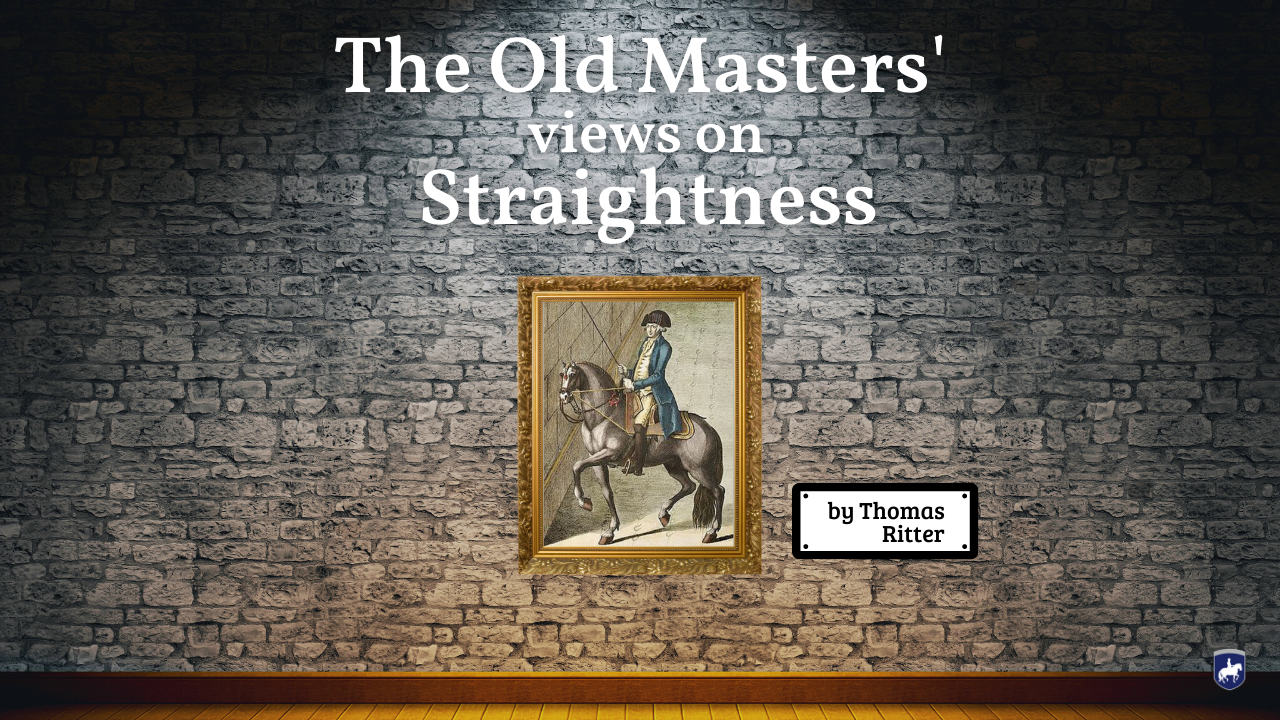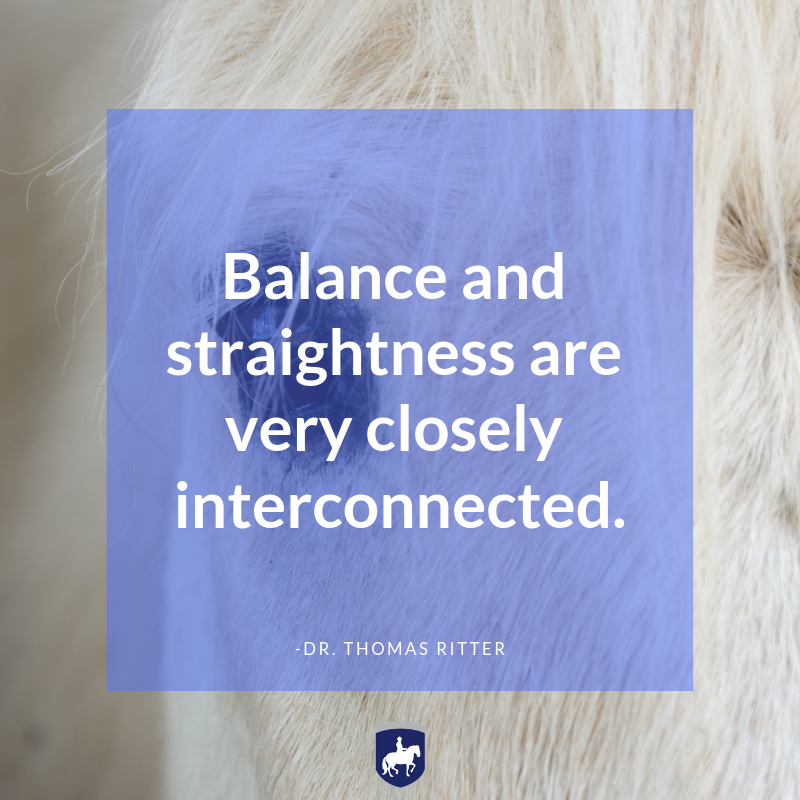The Old Masters considered the horse’s natural crookedness to be a major obstacle in developing balance, suppleness, collection, impulsion, and “obedience” (i.e. positive responsiveness to the aids). Put positively, functional straightness is the foundation of balance, suppleness, collection, impulsion, and “obedience”. Without straightness, the horse won’t get very far in his training. Unfortunately, overcoming crookedness is not a trivial matter. It requires constant attention, and if the rider doesn’t work on straightening her horse every day, his innate crookedness will gradually increase again.
This is why the famous French riding master Jacques d’Auvergne (1729-1798) said regarding the horse’s crookedness, “The horseman spends his entire life correcting this flaw through the perfection of his art.”
It’s interesting that despite all the differences in opinion between François Baucher and his school on one side and Gustav Steinbrecht and his followers on the other, both sides agree on the importance of straightness for the rideability of the horse.
General Alexis F.L’Hotte (1895), who was a student of both François Baucher and his opponent Vicomte d’Aure, wrote: “The straightness of the horse is of such importance that it constitutes – I have said this and am saying it again – the basis of Classical or savante equitation. And the straight position is the touchstone to lightness.”
General Faverot de Kerbrech, another famous student of Baucher’s, wrote in 1891: “One of the greatest challenges in riding is to keep the horse straight as consistently as possible, i.e. to achieve and maintain the position in which the forehand and the haunches line up with each other. As difficult as this may be, it is a main prerequisite for balancing the horse.”
De Kerbrech defines balance as the ease with which “the rider can change the distribution of the horse’s weight over his four legs”. He says: “The greater the fluidity and the smaller the difficulties are with which the weight can be redistributed in all directions, the more perfect is the horse’s balance.”
Along the same lines, you could say that functional straightness is the horse’s ability to move his hips and his shoulders equally easily to the left and the right, and to bend his spine equally easily to the left and the right.
The ability to shift the weight from one side of the body to the other enables the horse to move his hips and shoulders left and right, and conversely, moving his hips or shoulders to the left or to the right involves a weight shift in the direction of the movement. Balance and straightness are therefore very closely interconnected.
Colonel Waldemar Seunig, who spent some time as a young officer studying both in Saumur and at the Spanish Riding School, pointed out the close connection between straightness and permeability (1949), which is in turn closely connected to balance: “Permeability can only exist when, on the one hand, the thrust and impulsion from the hind legs reach the forehand undiminished, and on the other hand, when the weighting and flexing half-halts fully reach the hind legs. This requires the forehand and hindquarters to be aligned in such a way that, on a single track, the horse always adjusts his spine to the straight or curved line of travel, so that the hind legs follow in the same line as the front legs.”
So, you could say that without straightness, there is no balance, and without balance and straightness, there is no true permeability. The aids won’t go through.
Adolph Schmidt (1909) describes the alignment of the spine of a horse that is functionally straight very well like this: “If we imagine that the horse is moving between two parallel walls that touch his hips, his head and spine must be carried exactly in the middle between these two walls.”
You could draw the conclusion that if straightness and balance are prerequisites for permeability and “obedience”, their opposite - crookedness and imbalance - lead to resistance and potentially to the horse’s refusal to cooperate altogether.
Alexis L’Hotte (1895) explains: “However, if, when walking straight, the haunches deviate from the straight line as they follow the shoulders, one will see, at the same time, the following disintegrate: the harmonious relationship that existed between the forces of the forehand and the forces of the hindquarters; the precise distribution of weight; the ease with which one can take different directions; and how the haunches, in their opposition to the shoulders, will form a buttress. The result will be that the horse, like a string instrument, will have lost its chord.”
Brigadier Kurt Albrecht (1983) writes that: “Straightness is the soul of rideability – crookedness is the dangerous support base for all disobediences.”
Since straightness is a prerequisite for balance, lightness, and permeability, it makes sense to work on it from the very beginning, as Faverot de Kerbrech (1891) states explicitly: “From day one, we have to concentrate on straightening the horse, i.e. to align forehand and hindquarters correctly with each other.”
Paul Plinzner (1888), who edited Gustav Steinbrecht’s Gymnasium of the Horse manuscript for publication, and who actually wrote the chapters on canter and High School agrees with Faverot de Kerbrech: “As soon as the young horses have learned to follow each other willingly around the perimeter of the arena at the walk and trot with their noses low, one has to think immediately of adjusting forehand and hindquarters precisely along the direction of the movement, as this is the only way the thrust of the hindquarters toward the hand can be fully developed. By nature the young horse is inclined to step sideways instead of straight forward with one hind leg, usually the right one. In the enclosed arena the young horse will furthermore instinctively keep the same distance from the kickboard with his hips and shoulders, if he is left to his own devices. This brings him into a crooked position already, because every horse is wider in his hips than in his shoulders. The rider therefore has to try right from the beginning to move the outside shoulder away from the arena wall by shifting his weight and moving both hands a little towards the inside, especially on the right rein.”
Plinzner’s teacher, Gustav Steinbrecht (1884), who was a veterinarian as well as a rider, adds another important factor: “Forced elevation of the forehand, hard half halts, and primarily gaits with the horse in a crooked position in which the horse steps, instead of underneath the weight, to the side of it, are certain to damage the hocks.”
The loss of balance that results from crookedness leads to bracing and excessive wear and tear because the hind leg on the hollow/convave side doesn’t support the weight enough so the hind leg on the stiffer/convex side has to do more than its fair share of the work, and the front leg on the stiffer side has to support the largest share of the combined weight of horse and rider. The two legs on the stiffer side are therefore more susceptible to damage than the legs on the hollow side.
I find this little collection of quotes from classical literature interesting on several different levels. It gives us insight into the complex relationships between straightness, balance, permeability, soundness, and “obedience”. It also shows us that in spite of all disagreements between François Baucher and his German colleagues, there is quite a bit of common ground between them, because, after all, the laws of physics apply everywhere in the same way.




